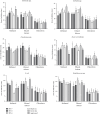Antimicrobial Activity of Tea and Agarwood Leaf Extracts Against Multidrug-Resistant Microbes
- PMID: 39734496
- PMCID: PMC11671646
- DOI: 10.1155/bmri/5595575
Antimicrobial Activity of Tea and Agarwood Leaf Extracts Against Multidrug-Resistant Microbes
Abstract
Emerging multidrug-resistant (MDR) strains are the main challenges to the progression of new drug discovery. To diminish infectious disease-causing pathogens, new antibiotics are required while the drying pipeline of potent antibiotics is adding to the severity. Plant secondary metabolites or phytochemicals including alkaloids, phenols, flavonoids, and terpenes have successfully demonstrated their inhibitory potential against the drug-resistant pathogens. In quest of potential phytochemicals, we selected tea (Camellia sinensis) and agarwood (Aquilaria malaccensis) leaves for antimicrobial activity. Fresh tea leaves were collected in three varieties, namely, BT-6, BT-7, and BT-8, including green tea (nonfermented tea), black tea (fully fermented tea), and agarwood leaves collected from Sylhet region of Bangladesh. This study is aimed at analyzing the phytochemical constituency and antimicrobial activity of tea and agarwood leaf extracts and analyzing if there is a combined effect or synergistic activity against multidrug-resistant pathogens. The antimicrobial activity of tea and agarwood leaf extracts was analyzed against MDR pathogenic bacteria and fungus. Qualitative and quantitative phytochemical constituency profiling of these six leaf extracts was evaluated, and preliminary screening exhibited that most of the leaves contained diverse groups of metabolites (alkaloids, tannin, flavonoids, glycosides, saponins, etc.). The highest amounts of TPC (total phenolic content) (110.16 ± 0.48 μg/mg) were found in BT-7 in ethanol extracts, and BT-8 in methanol extracts possessed the highest (128.1 ± 0.43 μg/mg) TFC (total flavonoid content). Notably, green tea showed remarkable results in TPC and TFC. In antioxidant scavenging activity, BT-7 and green tea showed significant IC50 values which were 13.23 and 20.75 mg/mL, respectively. In antimicrobial assays, both 50 μL of each tea and agarwood leaf extract antimicrobial activities were examined against 50 μL of each bacterial and fungal culture. In synergistic activity, 50 μL of each type of leaf extracts was poured over the commercial antibiotics to evaluate their synergism, additive, or antagonism activity against the multidrug-resistant pathogens. In the antimicrobial activity test, green tea showed a maximum diameter (22.0 ± 1.1 mm) zone of inhibition against Klebsiella pneumoniae whereas BT-8 showed 22.0 ± 2.5 mm against Pseudomonas aeruginosa. Indeed, fresh tea BT-6 and BT-7 both showed remarkable zone of inhibition against the selected microbes including Gram-negative and Gram-positive bacteria. Besides, leaf extract also showed antimicrobial activity against pathogenic fungus Mucor circinelloides. Aiming to increase antibiotic resistance efficacy, synergistic activities were evaluated among leaf extracts and antibiotics against the selected pathogens where synergism, antagonism, and additive results were noted. Combination of BT-8 extracts with antibiotics (ceftiofur) showed the highest synergism nearly 36 mm of the zone of inhibition against Escherichia coli. Additionally, green tea with gentamicin and erythromycin also showed remarkable synergism 35 and 33 mm against Mucor circinelloides and E. coli, respectively. Tea and agarwood leaves grown in Bangladesh possess high antioxidant activity, promising antibacterial and antifungal activity, thus might provide a potential source for drug discovery.
Keywords: agarwood leaves; antimicrobial activity; phytochemicals; synergistic activity; tea.
Copyright © 2024 Shah Rucksana Akhter Urme et al.
Conflict of interest statement
The authors declare no conflicts of interest.
Figures




Similar articles
-
Evaluation of the Antimicrobial Activity of Phytochemicals from Tea and Agarwood Leaf Extracts against Isolated Bacteria from Poultry and Curd.ScientificWorldJournal. 2023 Nov 7;2023:6674891. doi: 10.1155/2023/6674891. eCollection 2023. ScientificWorldJournal. 2023. PMID: 38021480 Free PMC article.
-
Exploring phytochemical, antioxidant, and antimicrobial properties of Plumeria pudica Jacq. leaves.Sci Rep. 2025 Jan 2;15(1):193. doi: 10.1038/s41598-024-83980-6. Sci Rep. 2025. PMID: 39747423 Free PMC article.
-
Antimicrobial activities evaluation and phytochemical screening of some selected medicinal plants: A possible alternative in the treatment of multidrug-resistant microbes.PLoS One. 2021 Mar 26;16(3):e0249253. doi: 10.1371/journal.pone.0249253. eCollection 2021. PLoS One. 2021. PMID: 33770121 Free PMC article.
-
A review on antimicrobial botanicals, phytochemicals and natural resistance modifying agents from Apocynaceae family: Possible therapeutic approaches against multidrug resistance in pathogenic microorganisms.Drug Resist Updat. 2020 Jul;51:100695. doi: 10.1016/j.drup.2020.100695. Epub 2020 Apr 8. Drug Resist Updat. 2020. PMID: 32442892 Review.
-
Bioactive Compounds from Guava Leaves (Psidium guajava L.): Characterization, Biological Activity, Synergistic Effects, and Technological Applications.Molecules. 2025 Mar 12;30(6):1278. doi: 10.3390/molecules30061278. Molecules. 2025. PMID: 40142053 Free PMC article. Review.
References
-
- Vlieghe E., Bal A., Gould I. M. Surveillance of antibiotic resistance in developing countries: needs, constraints and realities. In: Sosa A., Byarugaba D., Amábile-Cuevas C., Hsueh P. R., Kariuki S., Okeke I., editors. Antimicrobial Resistance in Developing Countries . New York, NY: Springer; 2010. - DOI
MeSH terms
Substances
LinkOut - more resources
Full Text Sources
Molecular Biology Databases

